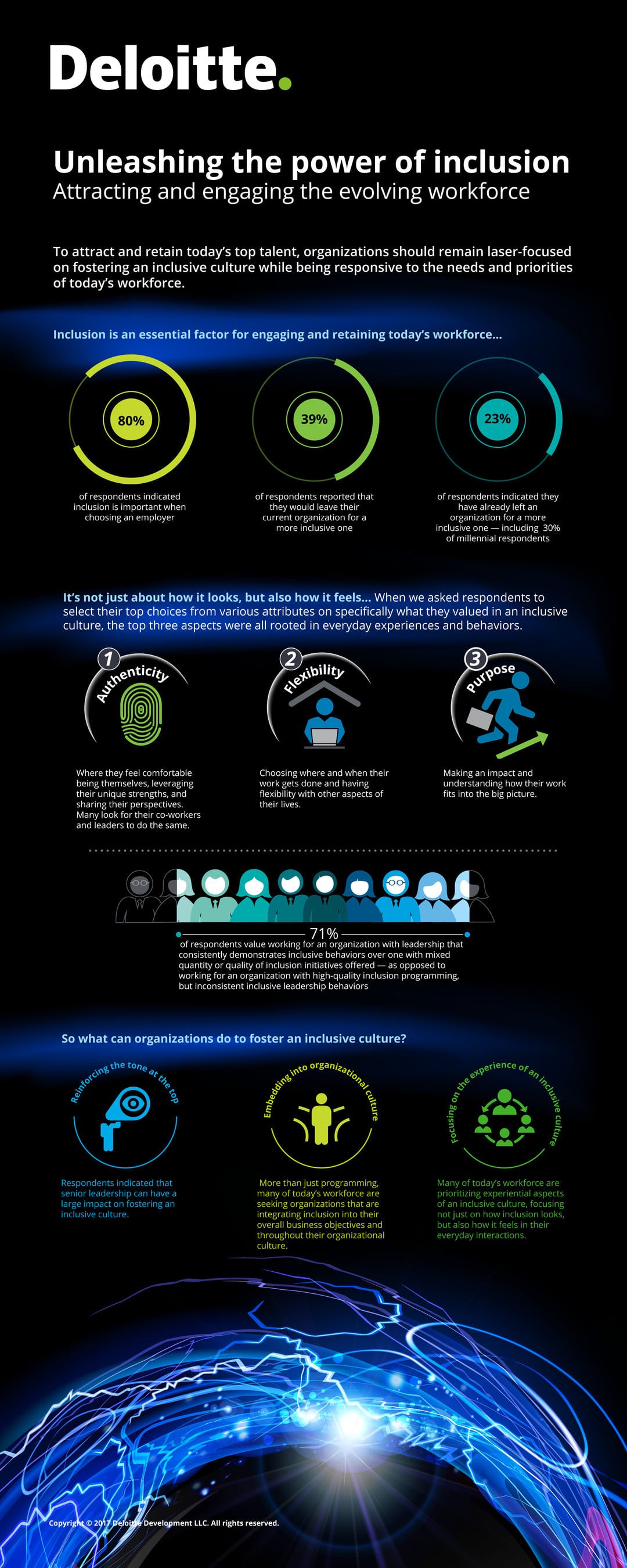As today’s workforce continues to evolve, professionals across generations cite inclusion as a key factor in determining whether they join, stay, or leave an organization. According to a new report from Deloitte and the Billie Jean King Leadership Initiative (BJKLI), Unleashing the power of inclusion: attracting and engaging the evolving workforce, 80 percent of full-time employees surveyed online from a range of different sized organizations and industries across the U.S. indicated that inclusion is important when choosing an employer.
“Inclusion is significant for professionals today,” said BJKLI founder and sports icon Billie Jean King, in a news release. “It is imperative that organizations cultivate and showcase an inclusive culture if they want to win the race for high-performing talent, particularly millennials who are a key driving force of the future workplace.”
“It is clear from our growing body of research that the evolving workforce—which now includes the entrance of Gen Z—will continue to disrupt how organizations approach inclusion,” said Deborah DeHaas, chief inclusion officer at Deloitte LLP, in the release. “Professionals today increasingly want their work to be a reflection of their personal identity—and organizations need to take that to heart.”
The new report, the third in a series of research reports focused on understanding the critical issues to achieve an inclusive culture, focuses on three areas:
- The impact inclusion has on attracting and retaining talent
- What the workforce priorities are in an inclusion culture; and
- What organizations can do to further embed inclusion into their culture
Challenging and redefining the status quo on inclusion
The definition of diversity and inclusion is shifting in the minds of today’s professionals. To truly move the needle and advance inclusion in their organizations, respondents emphasized that inclusion priorities should include how their leaders and peers demonstrate inclusive behaviors in decision-making.
When asked to rank aspects of an inclusive culture they value most, respondents cited the following top three factors: “an atmosphere where I feel comfortable being myself” (47 percent); “an environment that provides a sense of purpose, where I feel like I make an impact” (39 percent); and “a place where work flexibility (parental leave, remote working, etc.) is provided as a top priority” (37 percent). These findings were relatively consistent across demographics (e.g., race, gender, ethnicity, etc.).
“These three elements—authenticity, purpose and flexibility—is what it’s going to take for organizations to gain traction with their people and produce measurable results when it comes to inclusion,” said DeHaas.
“People don’t want to be just a checked box or another number in a diversity report, they want to make sure their presence is felt and welcomed,” said King. “We have to continue to push the status quo to help drive change.”
Moving beyond training and programming to foster inclusion
According to the report, many of today’s evolving workforce do not want inclusion to be solely a programmatic initiative or add-on—there’s an expectation for inclusion to be fully embedded into an organization’s foundational culture. Below are three recommendations to help organizations integrate inclusion into their overall strategy and structure:
- Reinforce the tone at the top: It is important for senior leadership to model inclusive behaviors that can be evaluated through performance expectation frameworks. Examples of behaviors include mentoring and sponsoring individuals from diverse backgrounds, and enabling employees to invest in their personal well-being in ways most meaningful to them.
- Integrate inclusion in overall business strategy and organizational culture: Throughout the talent lifecycle (e.g., recruitment, training, succession planning), organizations should clearly articulate and reinforce inclusive behaviors and development experiences for their professionals. For example, providing broader education and awareness around unconscious bias.
- Focus on experience and everyday behaviors: Organizations can go beyond traditional approaches to inclusion by embracing the intersectionality of their people, recognizing that each individual has distinct identities, strengths, and experiences that contribute to one’s unique and authentic self.
To attract and retain today’s top talent, organizations should remain laser-focused on fostering an inclusive culture, while being responsive to the needs and priorities of today’s workforce.








